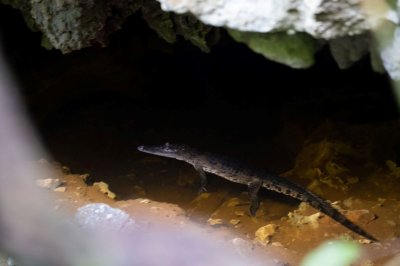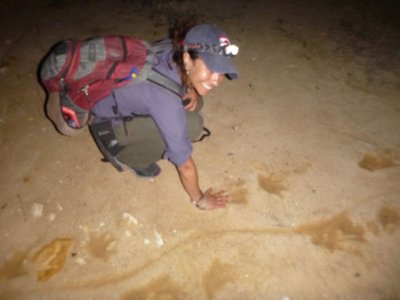
To Maya, crocodiles were considered integral to the underworld.
CROCODILE RESEARCH COALITION/CLINT LOCKWOOD
BY ROBYN WHITE ON 2/25/22
A population of cave-dwelling crocodiles in Belize could shed light on the ancient Maya civilization that once worshiped them, the Crocodile Research Coalition has said.
Researchers from the non-profit organization were exploring Maya caves at rainforest preserve, Runaway Creek, when they came across a 7 foot, 5 inch crocodile lurking in the water. The explorers also found the tracks of other crocodiles living in the caves.
The Maya civilization was an indigenous society in Mexico and Central America that existed from around 350 BC. Archeologists believe the Maya Empire reached its height from 250 AD to 900 AD.

Marica Tellez with the tracks of crocodiles found in the caves
.CROCODILE RESEARCH COALITION
Belize was at one point the center of the ancient Maya world. Today is it well known for its caves that were once integral to Maya culture. The indigenous people believed the caves were a gateway to the gods and often held religious ceremonies in them. Runaway Creek has over 50 caves, in which many artifacts have been found, providing glimpses into the ancient civilization. These include large and small clay pots, ax heads, arrowheads, grinding stones and various pottery shards.
Marisa Tellez, co-founder of the Crocodile Research Coalition, told Newsweek it has long been suspected that crocodiles "were not feared but revered" by the Maya. The cave-dwelling crocodiles could further prove suspicions that the reptiles were considered an animal with a special connection to the gods.
"In Maya religion or folklore, caves were the entrance to the underworld, Xibalba. Crocs were seen as guides to Xibalba," Tellez said. "So if a croc was observed in a cave, it was believed that croc was waiting for the spirit of someone who had recently died, so that the crocodile may guide them to the underworld where that spirit can reconnect with its ancestors as well as the gods."
In a Facebook post, the Crocodile Research Coalition said they will embark on a long-term project that will hopefully provide some insight into crocodile biology and physiology.
Studying these cave systems could also help researchers find new information on the crocodile's role in ancient Maya culture, Tellez said.
Marisa Tellez, co-founder of the Crocodile Research Coalition, told Newsweek it has long been suspected that crocodiles "were not feared but revered" by the Maya. The cave-dwelling crocodiles could further prove suspicions that the reptiles were considered an animal with a special connection to the gods.
"In Maya religion or folklore, caves were the entrance to the underworld, Xibalba. Crocs were seen as guides to Xibalba," Tellez said. "So if a croc was observed in a cave, it was believed that croc was waiting for the spirit of someone who had recently died, so that the crocodile may guide them to the underworld where that spirit can reconnect with its ancestors as well as the gods."
In a Facebook post, the Crocodile Research Coalition said they will embark on a long-term project that will hopefully provide some insight into crocodile biology and physiology.
Studying these cave systems could also help researchers find new information on the crocodile's role in ancient Maya culture, Tellez said.

The crocodile in the cave was 7.5 foot long.
CROCODILE RESEARCH COALITION/CLINT LOCKWOOD
"[These caves] could provide a glimpse of ceremonies and the local Maya's spiritual connection to caves and nature, information that has been lost due to time and colonization," Tellez said. "And of course, wildlife is part of our culture, part of our identity. Maybe we will also find more evidence of the respect the ancient Maya had for crocodiles that can further interest in local tolerance and conservation."
Crocodiles are not often found in caves, more usually preferring lakes, rivers and wetlands. Those that are found in caves are usually hiding from danger, rather than searching for prey.
In 2021, it was estimated that there are less than 200 American crocodiles left in Belize. The Crocodile Research Coalition is working to conserve the Belize population through research and habitat conservation.
"[These caves] could provide a glimpse of ceremonies and the local Maya's spiritual connection to caves and nature, information that has been lost due to time and colonization," Tellez said. "And of course, wildlife is part of our culture, part of our identity. Maybe we will also find more evidence of the respect the ancient Maya had for crocodiles that can further interest in local tolerance and conservation."
Crocodiles are not often found in caves, more usually preferring lakes, rivers and wetlands. Those that are found in caves are usually hiding from danger, rather than searching for prey.
In 2021, it was estimated that there are less than 200 American crocodiles left in Belize. The Crocodile Research Coalition is working to conserve the Belize population through research and habitat conservation.
READ MORE
Croc at Florida Zoo Breaks Out of Van, Makes Dash Down Road in Wild Video
Video of Dogs Being Fed to Crocodiles Stayed Live on YouTube for months
Magnificent Footage Shows Enormous Crocodile Resting Underwater in Florida
Croc at Florida Zoo Breaks Out of Van, Makes Dash Down Road in Wild Video
Video of Dogs Being Fed to Crocodiles Stayed Live on YouTube for months
Magnificent Footage Shows Enormous Crocodile Resting Underwater in Florida
No comments:
Post a Comment